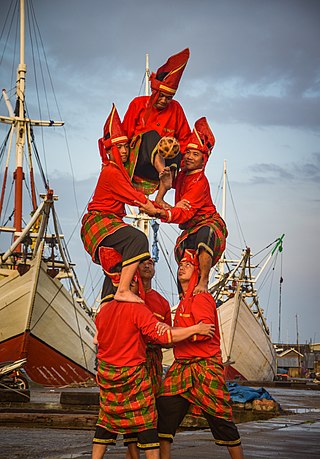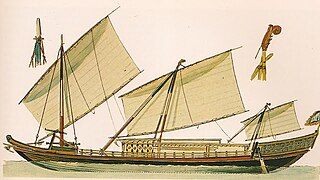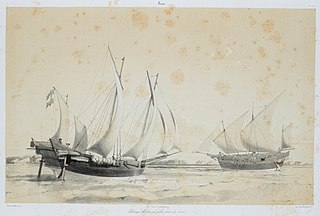

Padewakangs were traditional boats used by the Bugis, Mandar, and Makassar people of South Sulawesi. Padewakangs were used for long-distance voyages serving the south Sulawesi kingdoms.


Padewakangs were traditional boats used by the Bugis, Mandar, and Makassar people of South Sulawesi. Padewakangs were used for long-distance voyages serving the south Sulawesi kingdoms.
The origin of the name is unknown, though some have suggested that it stems from Dewakang Island, an important navigational landmark between Sulawesi and Java. Dutch records from the 1735 mention letters from Sulawesi arriving in Batavia ‘per praauw Paduackang’. [1]
According to Horridge, the words padewakang, paduwakang (Sulawesi) and paduwang (Madura) have its roots from word wa, wangka, waga, wangga, and bangka of Austronesian languages. The term is associated with outrigger perahu or small perahu. [2]

It typically weights between 20 and 50 tons, had one or two tripod masts with "lateen" (tanja) sails made of mat. Like other traditional vessels of the archipelago, it is steered using two quarter rudders. [3] : 184 [4] Between the end of the 16th century to early 20th century they routinely sailed for the coasts of northern Australia in search of teripang (sea cucumbers), armed with cannon of ancient origin, probably cetbang or lantaka. Padewakang were the biggest craft of South Sulawesi as trading vessel and as war fleets, used for hundreds of years sailing the seas between western New Guinea, the southern parts of the Philippines, and the Malay Peninsula. There is even a British publication of padewakang under full sail in the Persian Gulf. [5] : 134–137 They are used until the production stopped in favor of the famous Palari by the 20th century. The palari evolved from basic padewakang hull with fore-and-aft sails to its own hull model with indigenous "pinisi rig". [6] : 41–42 H. Warington Smyth described a large 2-masted padewakang built of giam wood. The dimension is as follows: 99 ft (30.2 m) long, 15 ft (4.6 m) wide, 12 ft (3.7 m) depth, 6 ft 3 inch (1.91 m) freeboard. The capacity was 60 koyan (145 metric tons), with 60 ft (18.3 m) mainmast, crewed by 16 men. [7] : 580
According to Horst Liebner, a Mandar maritime expert, pinisi sail originally mounted onto the hull of a padewakang and similar boats; however, when the sailors and craftsmen are increasingly aware of the way they are used, they selected only the palari (derived from lari—"to run") hull — a very pointed hull type and it is indeed the one that best suits the schooner sail.
This evolution takes place in several stages: The hull type is designed with more pointed and enhanced with some additional boards that causing the deck of the bow becomes lower than the main deck and the stern, and that the construction of the rolling beams seems to 'fly' behind stern boat (Konjo language: palari salompong ambeng rua kali); the next part of the stern deck (ambeng) is continued until the steering beams merge with it (palari salompong); and the last step is to increase the bow height so that the entire deck becomes straight.
This last type of hull is used until the pinisi boat is replaced with PLM (motorized sailboat) type. In the early 1970s thousands of pinisi-palari ships measuring up to 200 tonnes of cargo, the world's largest commercial sailing fleet at the time, had contacted all corners of the Indonesian seas and became the trading backbone of the people. [6] : 41–42

Makassar people from the region of Sulawesi in Indonesia began visiting the coast of Northern Australia sometime around the middle of the 18th century, first in the Kimberley region, and some decades later in Arnhem Land. They were men who collected and processed trepang, a marine invertebrate prized for its culinary value generally and for its supposed medicinal properties in Chinese markets. The term Makassan is generally used to apply to all the trepangers who came to Australia.

A jukung or kano, also known as cadik is a small wooden Indonesian outrigger canoe. It is a traditional fishing boat, but newer uses include "Jukung Dives", using the boat as a vehicle for small groups of SCUBA divers.

Trepanging is the act of collection or harvesting of sea cucumbers, known in Indonesian as trepang, Malay těripang, and used as food. The collector, or fisher, of trepang is a trepanger.

Literally, the word pinisi refers to a type of rigging of Indonesian sailing vessels. A pinisi carries seven to eight sails on two masts, arranged like a gaff-ketch with what is called 'standing gaffs' — i.e., unlike most Western ships using such a rig, the two main sails are not opened by raising the spars they are attached to, but the sails are 'pulled out' like curtains along the gaffs which are fixed at around the centre of the masts.

The term lambo or lamba refer to two types of traditional boats from Indonesia.

The Makassar or Makassarese people are an ethnic group that inhabits the southern part of the South Peninsula, Sulawesi in Indonesia. They live around Makassar, the capital city of the province of South Sulawesi, as well as the Konjo highlands, the coastal areas, and the Selayar and Spermonde islands. They speak Makassarese, which is closely related to Buginese, and also a Malay creole called Makassar Malay.

A Sandeq is a type of outrigger sailboat or trimaran used by the Mandarese people for fishing and as a means of transportation between islands. The size of Sandeq varies, with hulls ranging from 5 to 15 metres long and 0.5 to 1.5 metres wide. Its carrying capacity ranges from a few hundred kilograms to over 2 tons. The sleek shape of the Sandeq makes it more agile and faster than other sailboats. The name of the vessel comes from a word in the Mandar language that means pointy, referring to the bow's shape.

Tanja sail or tanja rig is a type of sail commonly used by the Austronesian people, particularly in Maritime Southeast Asia. It is also known as the tilted square sail, canted rectangular sail, rectangular balance lug, or balance lug sail in English. In historical sources, tanja sail is sometimes incorrectly referred to as lateen sail or simply square sail.

Pencalang is a traditional merchant ship from Nusantara. Historically it was also written as pantchiallang or pantjalang. It was originally built by Malay people from the area of Riau and the Malay Peninsula, but has been copied by Javanese shipwrights. By the end of the 17th century this ship has been built by Javanese and Chinese shipbuilders in and around Rembang. However it was a popular choice for Balinese skippers followed by Sulawesian skippers.

A chialoup was a type of sloop used in the East Indies, a combination of western (Dutch) and Nusantaran (Indonesian) technologies and techniques. Many of these "boat-ships" were produced by VOC shipwrights in Rembang and Juwana, where the majority of the workers were local Javanese. Chialoups were used by the Dutch East India Company and private merchant-sailors of western and Nusantaran origin.

Perahu Mayang or simply mayang is a type of fishing boat from Java, Indonesia. This type of boat is used mainly for fishing and trading. Historically, this indigenous vessel is also favored by European skippers and private merchants for trading in East Indies: 50% of them were using mayang and pencalang. It is mostly used in northern coast of Java. The major production site is in Rembang, Central Java.

Toop is a type of boat-ship produced in East Indies. Appeared at the end of the 18th century, and built in local shipyards, this type of boat is one of the results of the incorporation of 'Western' and 'Nusantaran' technologies that began in the shipyards of the 17th and 18th European trading companies. This type of boat is commonly used for long-distance shipping. In the first half of the 19th century, this was the most common type of boat used by sailors and traders in Nusantara. Majority of toop is owned by merchants from the western area of Nusantara.

Patorani is a traditional fishing boat from Makassar, Indonesia. It is used by Macassan people for fishing, transport, and trading since at least 17th century A.D. Historically this type of boat was used by Gowa Sultanate as war boat.

Leti leti is a type of traditional transport vessel from East Madura, Indonesia, especially from the administrative district of Sumenep. The leti leti is a recent development, the hull form and sail were developed in the 19th century. In 1979, sailing leti leti numbered about 1,000, but the number reduced over the next decades as more modern, motorized vessel appeared.

Janggolan refers to two different type of perahu from Indonesia. One is from Madura, and the other from Bali. The Madurese janggolan is a type of indigenously constructed boat, meanwhile Balinese janggolan is an indigenous boat with western-styled hull construction.

Benawa or banawa is a type of ship from Gowa, an old principality in the southwest corner of Sulawesi, Indonesia. The earliest record of this vessel is from Hikayat Banjar, which was written in or not long after 1663. In the present, this vessel is already extinct; being replaced by vessels with a similar hull, namely palari and padewakang.

Palari is a type of Indonesian sailing vessel from South Sulawesi. It was mainly used by the people of Ara and Lemo Lemo, for transporting goods and people. This vessel is rigged with pinisi rig, which often makes it better known as "Pinisi" instead of its name. In Singapore, palari is known as "Makassartrader".

Pajala is a type of traditional perahu from western South Sulawesi, Indonesia. It is used mainly for fishing, but in the present it's a Bugis/Makassar name for small to medium-sized boat hull.

A bago is a traditional boat built by the Mandar people of Sulawesi, Indonesia. The hull is of the pajala-type, lightly built and allowing for shallow displacement. The boat is long, with the mast only making up a quarter of its length. A bago can be readily identified as Mandarese boat by its rudderpost style. Smaller-sized bagos are often used as fishing boats from which fishermen cast their nets. The Mandar people prefer using a bago over an outrigger canoe.

Bagan or bagang is a fishing instrument that uses nets and lights so that it can be used for light fishing, originating from Indonesia. Bagan is floated out to the sea to catch fishes, squids, and shrimps, and remain in the sea for several days or even months. The catch would be transported to land using other boats.